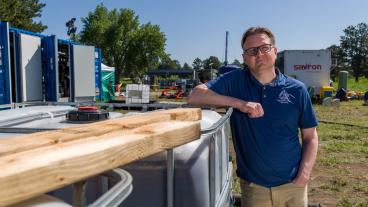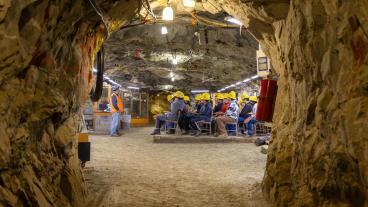Two Mines Geophysics PhD students have been awarded Future Investigators in NASA Earth and Space Science Technology (FINESST) award to put Earth science research into action to better understand the Earth’s climate system.
Colin Beyers and Zachary Katz are among the 55 graduate students from universities around the United States who were selected by NASA’s Earth Science Division to receive this highly competitive award.
FINESST provides graduate students with up to three years of funding of up to $50,000 a year to conduct self-designed and performed research projects, with a faculty member as a principal investigator. Since FINESST’s inception in 2007, more than 1,100 graduate students have had their research funded by the award.
Ocean surface waves and movement of particles

How do wind and currents drive the Stokes Drift, the variable movement of surface particles in the direction of ocean waves? And what role do waves play in upper ocean mixing?
That’s the focus of Beyers’ research with his faculty advisor, Geophysics Assistant Professor Bia Villas Bôas.
Looking at several different models and better understanding the pathways or trajectories of virtual particles, he hopes to shed light on how actual pollutants, nutrients and biogeochemical tracers in the ocean are transported by waves. In the long-term, his research could help to answer questions about how various kinds of items travel in the ocean, from litter to ships to people. That includes biological components of the ocean that sit lower on the food chain, like algae, and how that trickles up to affect other wildlife.
“If someone goes overboard on a ship, where are they going to go? If we drop garbage at a specific location, is it collecting in some area? Where is it going in general?” Beyers said. “Ocean waves can play a big role, and we don’t really understand that yet. So, understanding the role that waves play, and maybe controlling turbulence of the upper ocean, we can get to the bigger picture.”
Water under the Antarctic ice and sea level rise

Working with Geophysics Associate Professor Matt Siegfried, Katz is focused on the polar tides around Antarctica, and how they affect sea level rise and ice flow.
Antarctica isn’t the kind of environment where the usual tide monitoring tools in warmer parts of the ocean can be used, like gauges and buoys. Instead, Katz will combine satellite data of the Antarctic region with ground measurements from GPS stations to build a better understanding of Antarctic tides and how they impact ice flow.
Researchers have observed that the speed of ice flow around Antarctica can change over the same time periods that ocean tides change around Antarctica, but we still have a limited understanding of how tides affect ice motion on a continental scale, he said.
“I’m really interested in how these ice streams are moving,” he said. “We have a lot of observations about how they speed up and slow down corresponding to tides, but each ice stream changes completely differently from the rest. There’s no unified understanding of why one moves one way, and one moves the other way. If we can have a map of tides all around Antarctica, we’ll get a better idea of how these Antarctic streams interact with tides and possibly contribute to sea level rise.”




